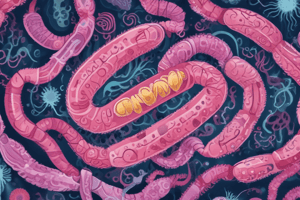Podcast
Questions and Answers
¿Cuál es el factor de virulencia de Campylobacter que facilita la unión a células epiteliales?
¿Cuál es el factor de virulencia de Campylobacter que facilita la unión a células epiteliales?
- Cytotoxinas
- Capsula
- Flagelas
- Adhesinas (correct)
¿Cuál es el mecanismo principal de transmisión de Vibrio cholerae?
¿Cuál es el mecanismo principal de transmisión de Vibrio cholerae?
- Persona a persona
- Agua y alimentos contaminados (correct)
- Contacto con animales infectados
- Vector insecto
¿Qué es lo que regula la producción de toxina Shiga en Shigella?
¿Qué es lo que regula la producción de toxina Shiga en Shigella?
- La presión osmótica
- El pH del entorno
- La temperatura corporal
- La disponibilidad de hierro (correct)
¿Cuál es el mecanismo por el que Salmonella invade células epiteliales intestinales?
¿Cuál es el mecanismo por el que Salmonella invade células epiteliales intestinales?
¿Cuál es la función de la capsula de Campylobacter?
¿Cuál es la función de la capsula de Campylobacter?
¿Qué es lo que produce la toxina Shiga en Shigella?
¿Qué es lo que produce la toxina Shiga en Shigella?
¿Cuál es el resultado de la invasión de células epiteliales intestinales por Salmonella?
¿Cuál es el resultado de la invasión de células epiteliales intestinales por Salmonella?
¿Cuál es el papel de los cilios flagelos en Campylobacter?
¿Cuál es el papel de los cilios flagelos en Campylobacter?
¿Cuál es el resultado de la producción de toxina Shiga en Shigella?
¿Cuál es el resultado de la producción de toxina Shiga en Shigella?
¿Cuál es el mecanismo de transmisión de Vibrio cholerae que involucra el contacto directo con una persona infectada?
¿Cuál es el mecanismo de transmisión de Vibrio cholerae que involucra el contacto directo con una persona infectada?
Flashcards are hidden until you start studying
Study Notes
Enteropathogens
Campylobacter virulence factors
- Flagella: Campylobacter's flagella allow for motility, invasion, and colonization of the intestinal epithelium.
- Adhesins: Campylobacter's adhesins (e.g., CadF, FlpA) facilitate binding to epithelial cells.
- Cytotoxins: Campylobacter's cytotoxins (e.g., CdtA, CdtB, CdtC) induce cellular damage and inflammation.
- Capsule: Campylobacter's capsule prevents complement-mediated killing and phagocytosis.
Vibrio cholerae transmission
- Contaminated food and water: V. cholerae is primarily transmitted through ingestion of contaminated food and water.
- Fecal-oral route: The bacterium is shed in the feces of infected individuals and can contaminate food and water sources.
- Person-to-person transmission: V. cholerae can also be transmitted through direct contact with an infected person's feces.
Shigella toxin production
- Shiga toxin: Shigella produces Shiga toxin, a potent cytotoxin that inhibits protein synthesis and induces cell death.
- Toxin production: Shigella toxin production is regulated by the bacterium's iron availability and pH.
- Toxin mechanisms: Shiga toxin disrupts the intestinal epithelial barrier, leading to inflammation and diarrhea.
Salmonella pathogenesis
- Invasion: Salmonella invades intestinal epithelial cells, using type III secretion systems to deliver effector proteins.
- Intracellular survival: Salmonella survives and replicates within host cells, evading immune responses.
- Inflammation: Salmonella triggers an inflammatory response, leading to tissue damage and diarrhea.
Aeromonas virulence mechanisms
- Adhesins: Aeromonas produces adhesins that facilitate binding to host cells and tissues.
- Toxins: Aeromonas produces cytotoxins, hemolysins, and enterotoxins that contribute to tissue damage and diarrhea.
- Biofilm formation: Aeromonas forms biofilms, which enhance its ability to adhere to surfaces and resist antimicrobial agents.
Studying That Suits You
Use AI to generate personalized quizzes and flashcards to suit your learning preferences.


